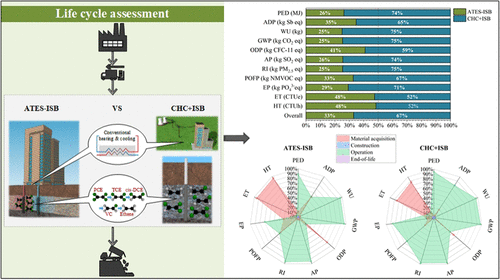当前位置:
X-MOL 学术
›
Environ. Sci. Technol.
›
论文详情
Our official English website, www.x-mol.net, welcomes your
feedback! (Note: you will need to create a separate account there.)
Comparative Life-Cycle Assessment of Aquifer Thermal Energy Storage Integrated with in Situ Bioremediation of Chlorinated Volatile Organic Compounds.
Environmental Science & Technology ( IF 10.8 ) Pub Date : 2020-02-18 , DOI: 10.1021/acs.est.9b07020 Zhuobiao Ni 1, 2 , Yue Wang 1 , Yafei Wang 1, 2 , Shaoqing Chen 1, 2 , Manxi Xie 1 , Tim Grotenhuis 3 , Rongliang Qiu 1, 2
Environmental Science & Technology ( IF 10.8 ) Pub Date : 2020-02-18 , DOI: 10.1021/acs.est.9b07020 Zhuobiao Ni 1, 2 , Yue Wang 1 , Yafei Wang 1, 2 , Shaoqing Chen 1, 2 , Manxi Xie 1 , Tim Grotenhuis 3 , Rongliang Qiu 1, 2
Affiliation

|
Due to the increasing need for sustainable energy and environmental quality in urban areas, the combination of aquifer thermal energy storage (ATES) and in situ bioremediation (ISB) has drawn much attention as it can deliver an integrated contribution to fulfill both demands. Yet, little is known about the overall environmental impacts of ATES-ISB. Hence, we applied a life-cycle assessment (LCA) to evaluate the environmental performance of ATES-ISB, which is also compared with the conventional heating and cooling system plus ISB alone (CHC + ISB). Energy supply via electricity is revealed as the primary cause of the environmental impacts, contributing 61.26% impacts of ATES-ISB and 72.91% impacts of CHC + ISB. Specifically, electricity is responsible for over 95% of water use, global warming potential, acidification potential, and respiratory inorganics, whereas the production of the biological medium for bioremediation causes more than 85% of the eco- and human toxicity impacts in both cases. The overall environmental impact of ATES-ISB is two times smaller than that of CHC + ISB. Sensitivity analysis confirms the importance of electricity consumption and electron donor production to the environmental impacts in both energy supply and bioremediation. Thus, future studies and practical applications seeking possible optimization of the environmental performances of ATES-ISB are recommended to focus more on these two essential elements, e.g., electricity and electron donor, and their related parameters. With the comprehensive LCA, insight is obtained for better characterizing the crucial factors as well as the relevant direction for future optimization research of the ATES-ISB system.
中文翻译:

含水层热能存储的生命周期评估与氯化挥发性有机化合物的原位生物修复相结合。
由于城市地区对可持续能源和环境质量的需求不断增长,含水层热能存储(ATES)和原位生物修复(ISB)的结合引起了广泛关注,因为它可以为满足这两个需求做出综合性贡献。然而,关于ATES-ISB的整体环境影响知之甚少。因此,我们应用了生命周期评估(LCA)来评估ATES-ISB的环境性能,并将其与传统的加热和冷却系统以及单独的ISB(CHC + ISB)进行比较。揭示了通过电力供应能源是造成环境影响的主要原因,其对ATES-ISB的影响为61.26%,对CHC + ISB的影响为72.91%。具体来说,电力占95%以上的用水量,全球变暖潜能,酸化潜能,以及呼吸性无机物,而在两种情况下,用于生物修复的生物介质的生产都会造成超过85%的生态和人类毒性影响。ATES-ISB的总体环境影响是CHC + ISB的两倍。敏感性分析证实了电力消耗和电子供体生产对能源供应和生物修复中的环境影响的重要性。因此,建议在未来的研究和实际应用中寻求对ATES-ISB的环境性能进行可能的优化,以将重点更多地放在这两个基本要素上,例如电和电子供体及其相关参数。有了全面的LCA,
更新日期:2020-02-18
中文翻译:

含水层热能存储的生命周期评估与氯化挥发性有机化合物的原位生物修复相结合。
由于城市地区对可持续能源和环境质量的需求不断增长,含水层热能存储(ATES)和原位生物修复(ISB)的结合引起了广泛关注,因为它可以为满足这两个需求做出综合性贡献。然而,关于ATES-ISB的整体环境影响知之甚少。因此,我们应用了生命周期评估(LCA)来评估ATES-ISB的环境性能,并将其与传统的加热和冷却系统以及单独的ISB(CHC + ISB)进行比较。揭示了通过电力供应能源是造成环境影响的主要原因,其对ATES-ISB的影响为61.26%,对CHC + ISB的影响为72.91%。具体来说,电力占95%以上的用水量,全球变暖潜能,酸化潜能,以及呼吸性无机物,而在两种情况下,用于生物修复的生物介质的生产都会造成超过85%的生态和人类毒性影响。ATES-ISB的总体环境影响是CHC + ISB的两倍。敏感性分析证实了电力消耗和电子供体生产对能源供应和生物修复中的环境影响的重要性。因此,建议在未来的研究和实际应用中寻求对ATES-ISB的环境性能进行可能的优化,以将重点更多地放在这两个基本要素上,例如电和电子供体及其相关参数。有了全面的LCA,











































 京公网安备 11010802027423号
京公网安备 11010802027423号